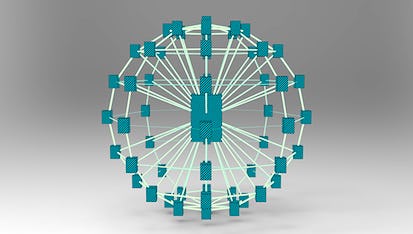- Level Foundation
- المدة 23 ساعات hours
- الطبع بواسطة University of Illinois Urbana-Champaign
-
Offered by

عن
Cloud computing systems today, whether open-source or used inside companies, are built using a common set of core techniques, algorithms, and design philosophies " all centered around distributed systems. Learn about such fundamental distributed computing "concepts" for cloud computing. Some of these concepts include: clouds, MapReduce, key-value/NoSQL stores, classical distributed algorithms, widely-used distributed algorithms, scalability, trending areas, and much, much more! Know how these systems work from the inside out. Get your hands dirty using these concepts with provided homework exercises. In the programming assignments, implement some of these concepts in template code (programs) provided in the C++ programming language. Prior experience with C++ is required. The course also features interviews with leading researchers and managers, from both industry and academia.الوحدات
Orientation
1
Videos
- Introduction to Cloud Computing Concepts, Part 1
3
Readings
- Orientation Overview
- Syllabus
- About the Discussion Forums
1
Quiz
- Orientation Quiz
Basic Computer Science Fundamentals
1
Assignment
- Prerequisite Quiz
1
Videos
- Orientation Towards Cloud Computing Concepts: Some Basic Computer Science Fundamentals
1
Readings
- Instructions for Taking the Prerequisite Quiz
Know Your Classmates
1
Discussions
- Getting to Know Your Classmates
1
Readings
- Course Learning Community and Social Media
Week 1 Overview: Introduction to Clouds, MapReduce
1
Videos
- Week 1 Introduction
1
Readings
- Week 1 Overview
Lesson 1: Introduction to Clouds
6
Videos
- 1.1. Why Clouds?
- 1.2. What is a Cloud?
- 1.3. Introduction to Clouds: History
- 1.4. Introduction to Clouds: What's New in Today's Clouds
- 1.5. Introduction to Clouds: New Aspects of Clouds
- 1.6. Introduction to Clouds: Economics of Clouds
Lesson 2: Clouds are Distributed Systems
2
Videos
- 2.1. A cloud IS a distributed system
- 2.2. What is a distributed system?
Lesson 3: MapReduce
4
Videos
- 3.1. MapReduce Paradigm
- 3.2. MapReduce Examples
- 3.3. MapReduce Scheduling
- 3.4. MapReduce Fault-Tolerance
Interview
1
Videos
- Interview with Sumeet Singh
Homework
1
Assignment
- Homework 1
1
Discussions
- Homework 1 Discussion
1
Readings
- Homework 1 Instructions
Programming Assignment
1
Readings
- Programming Assignment Instructions
Overview
1
Videos
- Week 2 Introduction
1
Readings
- Week 2 Overview
Lesson 1: Gossip
4
Videos
- 1.1. Multicast Problem
- 1.2. The Gossip Protocol
- 1.3. Gossip Analysis
- 1.4. Gossip Implementations
Lesson 2: Membership
6
Videos
- 2.1. What is Group Membership List?
- 2.2. Failure Detectors
- 2.3. Gossip-Style Membership
- 2.4. Which is the best failure detector?
- 2.5. Another Probabilistic Failure Detector
- 2.6. Dissemination and suspicion
Lesson 3: Grids
2
Videos
- 3.1. Grid Applications
- 3.2. Grid Infrastucture
Interview
1
Videos
- Interview with William Gropp
Homework
1
Discussions
- Homework 2 Discussion
1
Readings
- Homework 2 Instructions
1
Quiz
- Homework 2
Overview
1
Videos
- Week 3 Introduction
1
Readings
- Week 3 Overview
Lesson: P2P Systems
8
Videos
- 1. P2P Systems Introduction
- 2. Napster
- 3. Gnutella
- 4. FastTrack and BitTorrent
- 5. Chord
- 6. Failures in Chord
- 7. Pastry
- 8. Kelips
Interview
1
Videos
- Blue Waters Supercomputer
Homework
1
Discussions
- Homework 3 Discussion
1
Readings
- Homework 3 Instructions
1
Quiz
- Homework 3
Overview
1
Videos
- Week 4 Introduction
1
Readings
- Week 4 Overview
Lesson 1: Key-value stores
5
Videos
- 1.1. Why Key-Value/NOSQL?
- 1.2. Cassandra
- 1.3. The Mystery of X-The Cap Theorem
- 1.4. The Consistency Spectrum
- 1.5. HBase
Lesson 2: Time and Ordering
5
Videos
- 2.1. Introduction and Basics
- 2.2. Cristian's Algorithm
- 2.3. NTP
- 2.4. Lamport Timestamps
- 2.5. Vector Clocks
Interview
1
Videos
- Interview with Marcos Aguilera
1
Readings
- Optional: Lamport Timestamps (Ukulele Version)
Homework
1
Assignment
- Homework 4
1
Discussions
- Homework 4 Discussion
1
Readings
- Homework 4 Instructions
Overview
1
Videos
- Week 5 Introduction
1
Readings
- Week 5 Overview
Lesson 1: Snapshots
4
Videos
- 1.1. What is Global Snapshot?
- 1.2. Global Snapshot Algorithm
- 1.3. Consistent Cuts
- 1.4. Safety and Liveness
Lesson 2: Multicast
5
Videos
- 2.1. Multicast Ordering
- 2.2. Implementing Multicast Ordering 1
- 2.3. Implementing Multicast Ordering 2
- 2.4. Reliable Multicast
- 2.5. Virtual Synchrony
Lesson 3: Paxos
4
Videos
- 3.1. The Consensus Problem
- 3.2. Consensus In Synchronous Systems
- 3.3. Paxos, Simply
- 3.4. The FLP Proof [OPTIONAL]
Interview
1
Videos
- Interview with Tushar Chandra
Homework
1
Discussions
- Homework 5 Discussion
1
Readings
- Homework 5 Instructions
1
Quiz
- Homework 5
Programming Assignment
- Gossip Protocol
1
Readings
- IMPORTANT Update notes for Gossip Protocol submission (Oct 24, 2019)
Conclusion
1
Videos
- Conclusion to Cloud Computing Concepts, Part 1
Final Exam
1
Assignment
- Final Exam
1
Discussions
- Final Exam Discussion
1
Readings
- Final Exam Instructions
Final Reflection
1
Discussions
- Final Reflection
Auto Summary
Explore the essential concepts of cloud computing and distributed systems with "Cloud Computing Concepts, Part 1" by Coursera. This foundational IT & Computer Science course, led by expert instructors, covers key topics like MapReduce, NoSQL stores, and scalability. With 1380 minutes of content, hands-on C++ assignments, and insights from industry leaders, it's perfect for learners with C++ experience looking to deepen their understanding of cloud technologies. Available through Starter subscriptions.

Indranil Gupta


